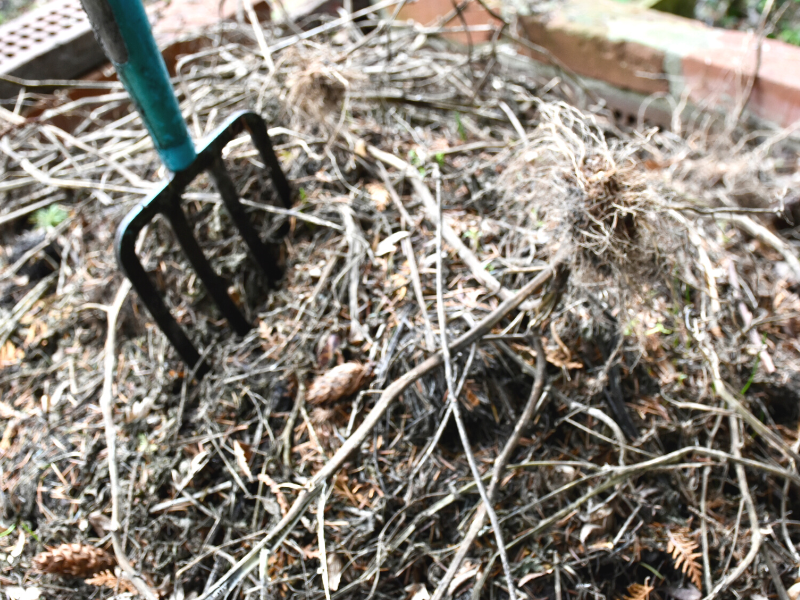How to improve aeration in your backyard compost bin

An ample supply of oxygen is key to the success of your backyard compost bin. Decomposer microbes need oxygen for their metabolic functions to operate efficiently. Without access to oxygen, some microbes die and others switch to a different form of metabolism, anaerobic (without air) respiration. This has a few negative consequences:
- Instead of the small amount of carbon dioxide produced in aerobic respiration, anaerobic conditions cause microbes to produce methane, a far more potent greenhouse gas.
- Anaerobic respiration also produces hydrogen sulfide– this is why anaerobic compost stinks!
- Anaerobic metabolism is slower than aerobic, so the finished compost will take longer.
Clearly, your compost pile will be a happier place when plenty of oxygen is available. But how can you make this happen? Here are a few ideas to help keep your compost breezy:
Use bulky materials on the bottom and throughout the pile
Large ingredients like sticks or big wood chips help create “pores” (spaces between the materials in the pile) that air can flow through. Before you build your pile, make a 4-5” layer of these bulky materials on the bottom of the bin and add your mix of greens and browns on top. When your pile begins to heat up and hot air rises up and out, this more open layer on the bottom will allow fresh air to rush in and replace it. You can build your pile on top of a wooden pallet for a similar effect. Adding in bulkier pieces throughout the pile will help with overall airflow as well; just note that these large chunks may take longer to decompose than the other materials in your pile. Once the rest of the compost is finished, you can simply take these pieces out and add them to your next pile.
Break up fresh materials
Fresh materials, like kitchen waste and weeds, tend to soften and compact in your compost pile. When kept in large pieces or clumped together, this can result in anaerobic pockets within the pile. Make sure any large pieces of fresh material are chopped into smaller pieces (aim for 1” or 2” cubes if you have the time) and mixed well with browns. Similarly, if you have a good amount of weeds or grass trimmings, it’s better to distribute them throughout the pile than to leave a heap of them together.
Keep your materials loose while creating your pile
“An ounce of prevention is worth a pound of cure” is a good motto for the home composter. A little extra care in building your pile can save you a good amount of time and effort in maintenance later on. One great way to prevent problems with limited airflow is to make sure your pile is layered loosely. To make this happen, set up your empty compost bin with a layer of bulky materials on the bottom. Then, mix your greens, browns, and the water you need outside of the bin– you can stir it up on the ground next to the bin, or in a wheelbarrow if you have one. Once it’s well mixed, gently layer your mixture into the bin with a compost fork or pitchfork. Don’t stir the mixture once it’s inside; this can cause compaction and negate your thoughtful work!
Add a passive aeration tube
Oxygen is most limited at the center of the compost pile, and air can only passively flow about 3 feet into a compost pile, meaning your pile should never be more than 6 feet across. However, you can go larger than this, or simply improve aeration in a smaller pile, by inserting a passive aeration tube in the center. An aeration tube can be made out of PVC pipe (at least 2” in diameter) that is taller than your pile and has large holes drilled through its length, or from hardware cloth rolled into a cylinder. Note, however, that this can also release some of the heat that builds up in the center of the pile and slow the process, so this may not be the best choice if you want to reap the benefits of hot composting.
Turn it around
While it’s the most physical strategy on this list, few things can bring air into your compost like a full footprint turn. This has the added benefit of redistributing the compostibles inside, exposing more materials to the heat at the center of the pile. If you’re hot composting, it’s best to do this after the pile has gone through its first peak in temperature and has dropped back down below 130° F. Pull the entire bin off the pile and place nearby, then thoroughly mix the materials, making sure to break up any anaerobic pockets (you’ll smell them) and add in moisture that was lost. If you started with a layer of bulky materials, move the partially-composted materials off before mixing and place the bulky pieces back in the bottom of your bin. After mixing, loosely layer materials back into the bin, just as you did with the initial build. Then sit back, relax, and watch as the fresh air and redistributed nitrogen heat the pile back up.
A final thought
Here in San Diego, composters are locked in a delicate balance between adequate moisture and airflow. Just as too much water can prevent air from moving freely, increased airflow can carry away moisture and deprive microbes of the water they need. If you take advantage of these tips but still want to optimize the compost process, note that you’ll want to monitor moisture levels and add extra water when needed.
Here’s to backyard composting success!
